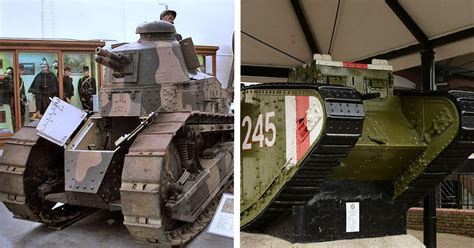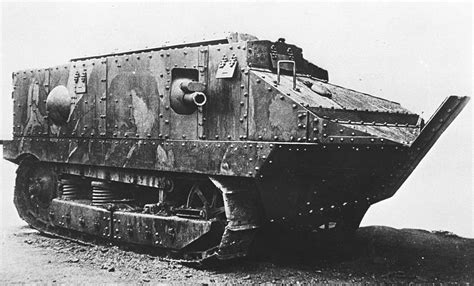The introduction of tanks in World War I marked a significant turning point in the history of modern warfare. The first tanks were deployed by the British in September 1916, during the Battle of the Somme, with the aim of breaking the stalemate of trench warfare that had characterized the conflict since its early days. The concept of armored vehicles had been around for centuries, but it wasn't until the early 20th century that the technology and materials became available to create a practical, battlefield-ready tank. The development and deployment of tanks were a response to the brutal and stagnant nature of World War I, where traditional infantry and cavalry tactics were proving ineffective against entrenched positions and machine gun fire.
The initial designs of tanks were primitive and suffered from numerous mechanical issues, but they paved the way for the rapid evolution of armored warfare. The first generation of tanks, such as the British Mark I, were slow, cumbersome, and often broke down, but they demonstrated the potential of armored vehicles to cross no man's land, withstand small arms fire, and provide covering fire for advancing troops. Despite their limitations, the psychological impact of tanks on the battlefield was significant, as they introduced a new element of fear and uncertainty among enemy troops. Over time, tanks became more sophisticated, with improvements in armor, firepower, and mobility, leading to their increased use in various roles, from infantry support to independent armored operations.
Key Points
- The first tanks were introduced by the British in 1916 during the Battle of the Somme.
- Early tanks were designed to break the stalemate of trench warfare and withstand machine gun fire.
- Despite initial mechanical issues, tanks demonstrated the potential for armored warfare and had a significant psychological impact on the battlefield.
- The development of tanks led to rapid improvements in design, with advancements in armor, firepower, and mobility.
- Tanks were initially used for infantry support but later took on more independent roles in armored operations.
Evolution of Tank Design and Deployment

The evolution of tank design during World War I was marked by a series of innovations aimed at addressing the mechanical and operational limitations of early models. One of the key challenges was increasing the reliability and mobility of tanks, which were often hampered by poor terrain and the lack of sufficient armor. The introduction of caterpillar tracks, for instance, significantly improved the mobility of tanks, allowing them to traverse difficult terrain more effectively. Additionally, advancements in armor plating and the introduction of more powerful engines enhanced the survivability and maneuverability of tanks on the battlefield.
The deployment of tanks also underwent significant changes as the war progressed. Initially, tanks were used in small numbers and in limited roles, primarily to support infantry advances. However, as their numbers and capabilities increased, tanks began to be used in more independent operations, such as armored raids and breakthrough attempts. The Germans, who initially lagged behind the Allies in tank development, eventually developed their own tank designs, including the A7V, which saw action in 1918. The use of tanks by both the Allies and the Central Powers marked a new era in warfare, one that would continue to evolve in the interwar period and play a decisive role in World War II.
Technical Specifications and Operational Performance
The technical specifications of early tanks varied significantly, reflecting the experimental nature of their design and the rapid pace of innovation during the war. The British Mark I, for example, was powered by a 105 horsepower Daimler engine, had a top speed of about 3 mph (4.8 km/h), and was armed with either two 6-pounder guns or four machine guns. The German A7V, introduced later in the war, was larger and more heavily armed, with a 100 horsepower engine and two 57mm guns, but it suffered from mechanical issues and was produced in limited numbers.
| Tank Model | Top Speed | Armament | Production Numbers |
|---|---|---|---|
| British Mark I | 3 mph (4.8 km/h) | 2 x 6-pounder guns or 4 x machine guns | 150 |
| German A7V | 4 mph (6.4 km/h) | 2 x 57mm guns | 20 |

Tactical Impact and Strategic Implications

The introduction of tanks had a profound tactical impact on the battlefield, offering a new means of breaking through enemy lines and supporting infantry advances. However, the strategic implications of tank warfare were more complex and multifaceted. The potential of tanks to revolutionize land warfare was recognized early on, but their development and deployment were also influenced by broader strategic considerations, including the need to maintain morale, the importance of coalition politics, and the imperative to innovate in the face of technological advancements by the enemy.
One of the significant strategic implications of tank warfare was the challenge it posed to traditional notions of warfare, particularly the dominance of infantry and cavalry on the battlefield. The emergence of tanks as a major factor in modern warfare necessitated a reevaluation of military doctrine and the development of new tactics and strategies that incorporated armored vehicles. This process of adaptation was not without its challenges, as it required significant investments in technology, training, and logistical support. Nonetheless, the incorporation of tanks into military forces marked a critical step towards the development of modern combined arms teams, where infantry, armor, artillery, and air support are integrated to achieve strategic objectives.
Historical Context and Evolutionary Developments
The historical context in which tanks were developed and deployed is crucial to understanding their significance in World War I. The war itself was a culmination of decades of military modernization and technological advancement, which had transformed the nature of warfare. The introduction of machine guns, barbed wire, and trench warfare had created a stalemate on the Western Front, where traditional military tactics were no longer effective. Against this backdrop, the development of tanks represented a desperate attempt to break the deadlock and restore mobility to the battlefield.
The evolutionary developments in tank design and deployment during World War I set the stage for the rapid advancements in armored warfare that would occur in the interwar period. The lessons learned from the early use of tanks, including the importance of reliability, mobility, and firepower, informed the development of new tank designs in the 1920s and 1930s. The interwar period also saw significant advancements in tank doctrine, with the development of armored divisions and the concept of blitzkrieg warfare, which would have a profound impact on the course of World War II.
What was the primary purpose of introducing tanks in World War I?
+The primary purpose of introducing tanks in World War I was to break the stalemate of trench warfare by providing a means to cross no man's land, withstand machine gun fire, and support infantry advances.
How did the development of tanks influence military doctrine and strategy during World War I?
+The development of tanks led to a reevaluation of military doctrine and strategy, emphasizing the importance of combined arms teams and the potential for armored warfare to break through enemy lines and achieve strategic objectives.
What were some of the significant challenges faced by early tank designs, and how were they addressed?
+Early tank designs faced challenges such as mechanical reliability, mobility, and armor protection. These challenges were addressed through innovations like the introduction of caterpillar tracks, improvements in armor plating, and the development of more powerful engines.
In conclusion, the introduction of tanks in World War I marked a pivotal moment in the history of warfare, representing a significant technological innovation that would have far-reaching implications for military strategy and doctrine. Despite their initial limitations, tanks demonstrated the potential for armored warfare to break the stalemate of trench warfare and paved the way for the development of modern combined arms teams. The legacy of World War I tanks can be seen in the continued evolution of armored warfare, from the interwar period through to the present day, highlighting the importance of technological innovation and strategic adaptation in the face of changing battlefield conditions.



